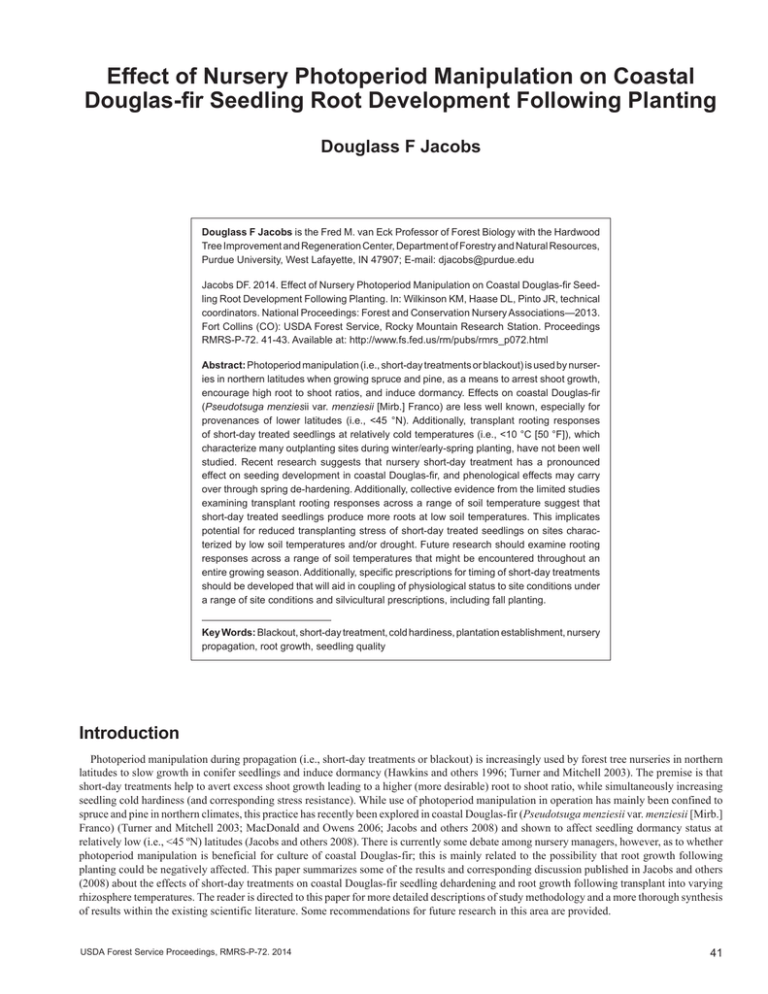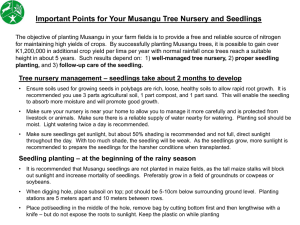Effect of Nursery Photoperiod Manipulation on Coastal
advertisement

Effect of Nursery Photoperiod Manipulation on Coastal Douglas-fir Seedling Root Development Following Planting Douglass F Jacobs Douglass F Jacobs is the Fred M. van Eck Professor of Forest Biology with the Hardwood Tree Improvement and Regeneration Center, Department of Forestry and Natural Resources, Purdue University, West Lafayette, IN 47907; E-mail: djacobs@purdue.edu Jacobs DF. 2014. Effect of Nursery Photoperiod Manipulation on Coastal Douglas-fir Seedling Root Development Following Planting. In: Wilkinson KM, Haase DL, Pinto JR, technical coordinators. National Proceedings: Forest and Conservation Nursery Associations—2013. Fort Collins (CO): USDA Forest Service, Rocky Mountain Research Station. Proceedings RMRS-P-72. 41-43. Available at: http://www.fs.fed.us/rm/pubs/rmrs_p072.html Abstract: Photoperiod manipulation (i.e., short-day treatments or blackout) is used by nurseries in northern latitudes when growing spruce and pine, as a means to arrest shoot growth, encourage high root to shoot ratios, and induce dormancy. Effects on coastal Douglas-fir (Pseudotsuga menziesii var. menziesii [Mirb.] Franco) are less well known, especially for provenances of lower latitudes (i.e., <45 °N). Additionally, transplant rooting responses of short-day treated seedlings at relatively cold temperatures (i.e., <10 °C [50 °F]), which characterize many outplanting sites during winter/early-spring planting, have not been well studied. Recent research suggests that nursery short-day treatment has a pronounced effect on seeding development in coastal Douglas-fir, and phenological effects may carry over through spring de-hardening. Additionally, collective evidence from the limited studies examining transplant rooting responses across a range of soil temperature suggest that short-day treated seedlings produce more roots at low soil temperatures. This implicates potential for reduced transplanting stress of short-day treated seedlings on sites characterized by low soil temperatures and/or drought. Future research should examine rooting responses across a range of soil temperatures that might be encountered throughout an entire growing season. Additionally, specific prescriptions for timing of short-day treatments should be developed that will aid in coupling of physiological status to site conditions under a range of site conditions and silvicultural prescriptions, including fall planting. Key Words: Blackout, short-day treatment, cold hardiness, plantation establishment, nursery propagation, root growth, seedling quality Introduction Photoperiod manipulation during propagation (i.e., short-day treatments or blackout) is increasingly used by forest tree nurseries in northern latitudes to slow growth in conifer seedlings and induce dormancy (Hawkins and others 1996; Turner and Mitchell 2003). The premise is that short-day treatments help to avert excess shoot growth leading to a higher (more desirable) root to shoot ratio, while simultaneously increasing seedling cold hardiness (and corresponding stress resistance). While use of photoperiod manipulation in operation has mainly been confined to spruce and pine in northern climates, this practice has recently been explored in coastal Douglas-fir (Pseudotsuga menziesii var. menziesii [Mirb.] Franco) (Turner and Mitchell 2003; MacDonald and Owens 2006; Jacobs and others 2008) and shown to affect seedling dormancy status at relatively low (i.e., <45 ºN) latitudes (Jacobs and others 2008). There is currently some debate among nursery managers, however, as to whether photoperiod manipulation is beneficial for culture of coastal Douglas-fir; this is mainly related to the possibility that root growth following planting could be negatively affected. This paper summarizes some of the results and corresponding discussion published in Jacobs and others (2008) about the effects of short-day treatments on coastal Douglas-fir seedling dehardening and root growth following transplant into varying rhizosphere temperatures. The reader is directed to this paper for more detailed descriptions of study methodology and a more thorough synthesis of results within the existing scientific literature. Some recommendations for future research in this area are provided. USDA Forest Service Proceedings, RMRS-P-72. 2014 41 Jacobs Effect of Nursery Photoperiod Manipulation on Coastal Douglas-fir Seedling Root Development Following Planting Photoperiod Manipulation and Seedling Phenology Seedling phenology is regulated by photoperiod in many temperate species; cold hardiness development is initiated by photoperiod reduction and coincides with growth cessation. Short-day treatment consistently induces early bud set during nursery culture, but can also result in earlier budbreak after outplanting (Hawkins and others 1996; Turner and Mitchell 2003), indicating that phenological and physiological impacts of photoperiod manipulation persist through winter cold storage and into the early stages of seedling establishment. Jacobs and others (2008) confirmed this pattern as they reported that short-day treated Douglas-fir seedlings generally had greater cold tolerance than ambient (long-day) treated seedlings after removal from freezer storage at periodic sampling points between January through May. Root growth capacity is strongly related to the bud dormancy cycle (Ritchie and Dunlap 1980), and so short-day treatments during nursery culture could affect timing and vigor of subsequent root growth. Photoperiod Manipulation and Transplant Root Growth Vigorous root development following field planting is necessary to minimize potential for seedling physiological drought and ensure survival (Grossnickle 2005). Root growth of newly planting conifers is optimized at around 20 ºC (68 °F) soil temperature (Lopushinsky and Max 1990), but soil temperature on most temperate outplanting during winter or early spring is usually relatively cold (i.e., <10 ºC [50 °F]). Thus, soil temperature is an important consideration when examining potential for new root growth immediately following planting. However, the interaction between soil temperature and seedling dormancy status and its affect on new root growth is a relatively unexplored area of research. Turner and Mitchell (2003) reported that root growth capacity was reduced for Douglas-fir seedlings with earlier vs. later short-day treatment initiation date, but they included no long-day treatment and soil temperature was not reported. MacDonald and Owens (2006) found that short-day treatment did not affect Douglas-fir seedling root growth capacity after transplant into pots, but they used a constant air temperature of 20 ºC (68 °F) and soil temperature was again not reported. Hawkins and Shewan (2000), studying interior spruce seedlings, showed that short-day treatments resulted in less new roots than long-day treatment following transplant into hydroponics for 7 days, but they only examined a root zone temperature of 20 ºC (68 °F). In Jacobs and others (2008), Douglas-fir seedlings that were either short-day or ambient (long-day) treated during the latter part of the growing season were lifted from storage at five different sampling dates (January-May) and transplanted into hydroponic root zone temperatures of 10, 15, 20, and 25 ºC (50, 59, 68, and 77 °F) in a controlled growth room environment. Numbers and biomass of new roots (figure 1) were sampled at the end of each 4-week treatment period. A photoperiod by root temperature interaction occurred, with no effect of sampling date. Short-day treated seedlings had more new roots at 10 ºC (50 °F), but the opposite effect occurred for both new roots and new root dry mass at 20 ºC (68 °F). Grossnickle and others (1991a) is the only other known published report to examine transplant rooting response of short-day cultured seedlings under more than one root temperature regime. They examined photoperiod responses of western hemlock seedlings in combination with abbreviated or long watering regimes on transplant rooting in hydroponics at 5 and 22 ºC (41 and 72 °F) root zone temperatures for Figure 1. Experimental Douglas-fir seedlings showing new root development following growth in a hydroponic system under controlled root zone temperatures. 42 USDA Forest Service Proceedings, RMRS-P-72. 2014 Effect of Nursery Photoperiod Manipulation on Coastal Douglas-fir Seedling Root Development Following Planting 14 days and found similar responses to Jacobs and others (2008). In a complementary field trial, Grossnickle and others (1991b) reported that short-day treated seedlings had increased root proliferation 1 month following planting. Better adaptability of short-day treated seedlings to low root zone temperatures was likely due to greater seedling stress resistance and decreased resistance to water movement at low soil temperatures (Grossnickle and others 1991a,b; Jacobs and others 2008). This evidence suggests greater water flow efficiency for shortday treated seedlings immediately after early-spring planting when soil temperatures are still low and, therefore, potential for reduced transplanting stress. Conclusions and Future Directions Short-day treatment in the nursery has a large effect on seedling morphology and physiology and although this practice has been applied mainly to species and provenances of higher latitudes, it is also relevant to more southerly seed sources of some species (e.g., coastal Douglas-fir). Increased cold tolerance characteristic of short-day treated seedlings in fall apparently may be maintained through spring. The limited research evaluating transplant rooting response of short-day treated seedlings suggests that these seedlings should be targeted for sites where low soil temperature is expected immediately after planting. There are many unanswered questions remaining regarding effects of photoperiod manipulation on seedling development, especially for southerly sources and species adapted to mild climates such as coastal Douglas-fir. One example is: Rooting responses associated with the timing of short-day treatments in relation to natural growth rhythms (Fløistad 2002). In other words, how can we adjust the starting and ending points of short-day treatments, as well as their duration within (i.e., number of daylength hours) to optimize seedling development for given species and provenances? A need also exists to identify trends in root growth at different soil temperatures throughout the growing season (Iivonen and others 2001). The few studies that have examined transplant rooting responses at varying temperatures have done so over very short time periods (i.e., several weeks). It would be useful to know if trends in root growth for short-day treated seedlings vary as soil warms throughout the growing season and into fall. Finally, as interest continues to grow in planting beyond the traditional winter/spring period, it would be valuable to examine transplant rooting responses of short-day treated seedlings during fall to aid in coupling of physiological status to site conditions for fall planting. Jacobs References Fløistad IS. 2002. Effects of excessive nutrient supply and short day treatment on autumn frost hardiness and time of bud break in Picea abies seedlings. Scan. J. For. Res. 17:295-303. Hawkins CDB, Shewan KB. 2000. Frost hardiness, height, and dormancy of 15 short-day, nursery treated interior spruce seed lots. Can. J. For. Res. 30:1096-1105. Hawkins CDB, Eastham AM, Story TL, Eng RYN, Draper DA. 1996. The effect of nursery blackout application on Sitka spruce seedlings. Can. J. For. Res. 26:2201-2213. Grossnickle SC. 2005. Importance of root growth in overcoming planting stress. New For. 30:273-294. Grossnickle SC, Arnott JT, Major JE, Tschaplinski TJ. 1991a. Influence of dormancy induction treatments on western hemlock seedlings. I. Seedling development and stock quality assessment. Can. J. For. Res. 21:164-174. Grossnickle SC, Arnott JT, Major JE. 1991b. Influence of dormancy induction treatments on western hemlock seedlings. I. Physiological and morphological response during the first growing season on a reforestation site. Can. J. For. Res. 21:175-185. Iivonen S, Rikala R, Vapaavuori E. 2001. Seasonal root growth of Scots pine seedlings in relation to shoot phenology, carbohydrate status, and nutrient supply. Can. J. For. Res. 31:1569-1578. Jacobs DF, Davis AS, Wilson BC, Dumroese RK, Goodman RC, Salifu KF. 2008. Short-day treatment alters Douglas-fir seedling dehardening and transplant root proliferation at varying rhizosphere temperatures. Canadian Journal of Forest Research 38:1526-1535. Lopushinsky W, Max TA. 1990. Effect of soil temperature on root and shoot growth and on budburst timing in conifer seedling transplants. New For. 4:107–124. MacDonald JE, Owens JN. 2006. Morphology, physiology, survival, and field performance of containerized coastal Douglas-fir seedlings given different dormancy-inducing regimes. HortSci. 41:1416-1420. Ritchie GA, Dunlap JR. 1980. Root growth potential: its development and expression in forest tree seedlings. New Zeal. J. For. Sci. 10:218-248. Turner J, Mitchell SJ. 2003. The effect of short day treatments on containerized Douglas-fir morphology, physiology and phenology. New For. 26:279-295. Acknowledgments I appreciate funding support from the Sierra Cascade Intensive Forest Management Cooperative and the Hardwood Tree Improvement and Regeneration Center. Tom Jopson at Cal Forest Nursery provided important recommendations and helped to coordinate treatment installations and shipping of samples. Anthony Davis, Diane Haase, Nabil Khadduri, Mike Taylor, and John Trobaugh all provided excellent input in developing this presentation and paper. USDA Forest Service Proceedings, RMRS-P-72. 2014 43






